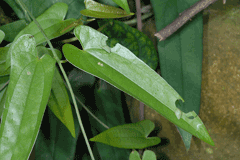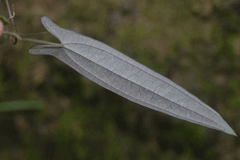 |
|
http://flickr.com/photos/68821308%40N00/1310577941 |
 |
| http://flickr.com/photos/plj/ |
Translate this page:
Summary
Physical Characteristics

 Dioscorea japonica is a PERENNIAL CLIMBER growing to 3 m (9ft 10in).
Dioscorea japonica is a PERENNIAL CLIMBER growing to 3 m (9ft 10in).
See above for USDA hardiness. It is hardy to UK zone 8. It is in flower from September to October. The species is dioecious (individual flowers are either male or female, but only one sex is to be found on any one plant so both male and female plants must be grown if seed is required). . The plant is not self-fertile.
Suitable for: light (sandy), medium (loamy) and heavy (clay) soils and prefers well-drained soil. Suitable pH: mildly acid, neutral and basic (mildly alkaline) soils. It cannot grow in the shade. It prefers moist soil.
UK Hardiness Map
US Hardiness Map
Synonyms
Plant Habitats
Woodland Garden Sunny Edge; Cultivated Beds;
Edible Uses
Edible Parts: Leaves Root
Edible Uses:
Tuber - cooked[174, 177, 179]. A very pleasant mild flavour with a floury texture, the roots can be eaten as a potato substitute[2]. The starch can be used as a binding agent for other foods[183]. Roots contain about 1.9% protein, 20% carbohydrate, 0.1% fat and 1% ash[179]. Leaf tips - cooked[183]. Tubercles - cooked[183].
References More on Edible Uses
Medicinal Uses
Plants For A Future can not take any responsibility for any adverse effects from the use of plants. Always seek advice from a professional before using a plant medicinally.
Contraceptive Miscellany Tonic
The tubers are prescribed in the treatment of diarrhoea, enteritis, enuresis and spermatorrhoea[218]. They are also dried and cut into shavings then used as a tonic[218]. The roots of most, if not all, members of this genus, contains diosgenin[222, 240]. This is widely used in modern medicine in order to manufacture progesterone and other steroid drugs. These are used as contraceptives and in the treatment of various disorders of the genitary organs as well as in a host of other diseases such as asthma and arthritis[222].
References More on Medicinal Uses
The Bookshop: Edible Plant Books
Our Latest books on Perennial Plants For Food Forests and Permaculture Gardens in paperback or digital formats.

Edible Tropical Plants
Food Forest Plants for Hotter Conditions: 250+ Plants For Tropical Food Forests & Permaculture Gardens.
More

Edible Temperate Plants
Plants for Your Food Forest: 500 Plants for Temperate Food Forests & Permaculture Gardens.
More

More Books
PFAF have eight books available in paperback and digital formats. Browse the shop for more information.
Shop Now
Other Uses
References More on Other Uses
Cultivation details
We have very little information on this species and do not know if it will be hardy in Britain, though judging by its native range it could succeed outdoors at least in the mildest areas of this country. The following notes are based on the general needs of the genus. Easily grown in a fertile well-drained soil in a sunny position or light shade[200]. Prefers a rich light soil[1]. Plants produce tubercles (small tubers that are formed in the leaf axils of the stems), and can be propagated by this means[K]. A climbing plant that supports itself by twining around the branches of other plants[219]. Dioecious. Male and female plants must be grown if seed is required. For polyculture design as well as the above-ground architecture (form - tree, shrub etc. and size shown above) information on the habit and root pattern is also useful and given here if available. Growth habit is a single or multiple shooting vine from a crown [1-2]. Herbaceous. The root pattern is tuberous with swollen potato-like roots [1-2].
References Carbon Farming Information and Carbon Sequestration Information
Temperature Converter
Type a value in the Celsius field to convert the value to Fahrenheit:
Fahrenheit:
The PFAF Bookshop
Plants For A Future have a number of books available in paperback and digital form. Book titles include Edible Plants, Edible Perennials, Edible Trees,Edible Shrubs, Woodland Gardening, and Temperate Food Forest Plants. Our new book is Food Forest Plants For Hotter Conditions (Tropical and Sub-Tropical).
Shop Now
Plant Propagation
Seed - sow March to April in a sunny position in a warm greenhouse and only just cover. It germinates in 1 - 3 weeks at 20°c[175]. Prick out the seedlings as soon as they are large enough to handle and grow on in a greenhouse for their first year. Plant out in late spring as the plant comes into new growth. Basal stem cuttings in the summer[37]. Division in the dormant season, never when in growth[1]. The plant will often produce a number of shoots, the top 5 - 10 cm of the root below each shoot can be potted up to form a new plant whilst the lower part of the root can be eaten[K]. Tubercles (baby tubers) are formed in the leaf axils. These are harvested in late summer and early autumn when about the size of a pea and coming away easily from the plant. They should be potted up immediately in individual pots in a greenhouse or cold frame. Plant out in early summer when in active growth[K].
Other Names
If available other names are mentioned here
Yamaimo, Japanese Wild Yam, Glutinous Yam, Japanese Cinnamon Vine, mukago, East Asian mountain yam, Japanese mountain yam, French: igname du Japon
Native Range
TEMPERATE ASIA: Anhui Sheng, Fujian Sheng, Guangdong Sheng, Guangxi Zhuangzu Zizhiqu, Guizhou Sheng (east & south), Honshu, Hubei Sheng, Hunan Sheng, Japan, Jiangsu Sheng, Jiangxi Sheng, Korea, Kyushu, Ryukyu Islands, Shikoku, Sichuan Sheng, Taiwan, Zhejiang Sheng,China.
Weed Potential
Right plant wrong place. We are currently updating this section.
Please note that a plant may be invasive in one area but may not in your area so it's worth checking.
Conservation Status
IUCN Red List of Threatened Plants Status :

Growth: S = slow M = medium F = fast. Soil: L = light (sandy) M = medium H = heavy (clay). pH: A = acid N = neutral B = basic (alkaline). Shade: F = full shade S = semi-shade N = no shade. Moisture: D = dry M = Moist We = wet Wa = water.
Now available:
Food Forest Plants for Mediterranean Conditions
350+ Perennial Plants For Mediterranean and Drier Food Forests and Permaculture Gardens.
[Paperback and eBook]
This is the third in Plants For A Future's series of plant guides for food forests tailored to
specific climate zones. Following volumes on temperate and tropical ecosystems, this book focuses
on species suited to Mediterranean conditions—regions with hot, dry summers and cool, wet winters,
often facing the added challenge of climate change.
Read More
Expert comment
Author
Thunb.
Botanical References
58266
Links / References
For a list of references used on this page please go here
Readers comment
© 2010, Plants For A Future. Plants For A Future is a charitable company limited by guarantee, registered in England and Wales. Charity No. 1057719, Company No. 3204567.